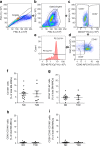Bone marrow pericyte dysfunction in individuals with type 2 diabetes
- PMID: 31001672
- PMCID: PMC6560025
- DOI: 10.1007/s00125-019-4865-6
Bone marrow pericyte dysfunction in individuals with type 2 diabetes
Erratum in
-
Correction to: Bone marrow pericyte dysfunction in individuals with type 2 diabetes.Diabetologia. 2019 Jul;62(7):1315. doi: 10.1007/s00125-019-4902-5. Diabetologia. 2019. PMID: 31115642 Free PMC article.
Abstract
Aims/hypothesis: Previous studies have shown that diabetes mellitus destabilises the integrity of the microvasculature in different organs by damaging the interaction between pericytes and endothelial cells. In bone marrow, pericytes exert trophic functions on endothelial cells and haematopoietic cells through paracrine mechanisms. However, whether bone marrow pericytes are a target of diabetes-induced damage remains unknown. Here, we investigated whether type 2 diabetes can affect the abundance and function of bone marrow pericytes.
Methods: We conducted an observational clinical study comparing the abundance and molecular/functional characteristics of CD146+ pericytes isolated from the bone marrow of 25 individuals without diabetes and 14 individuals with uncomplicated type 2 diabetes, referring to our Musculoskeletal Research Unit for hip reconstructive surgery.
Results: Immunohistochemistry revealed that diabetes causes capillary rarefaction and compression of arteriole size in bone marrow, without changing CD146+ pericyte counts. These data were confirmed by flow cytometry on freshly isolated bone marrow cells. We then performed an extensive functional and molecular characterisation of immunosorted CD146+ pericytes. Type 2 diabetes caused a reduction in pericyte proliferation, viability, migration and capacity to support in vitro angiogenesis, while inducing apoptosis. AKT is a key regulator of the above functions and its phosphorylation state is reportedly reduced in the bone marrow endothelium of individuals with diabetes. Surprisingly, we could not find a difference in AKT phosphorylation (at either Ser473 or Thr308) in bone marrow pericytes from individuals with and without diabetes. Nonetheless, the angiocrine signalling reportedly associated with AKT was found to be significantly downregulated, with lower levels of fibroblast growth factor-2 (FGF2) and C-X-C motif chemokine ligand 12 (CXCL12), and activation of the angiogenesis inhibitor angiopoietin 2 (ANGPT2). Transfection with the adenoviral vector carrying the coding sequence for constitutively active myristoylated AKT rescued functional defects and angiocrine signalling in bone marrow pericytes from diabetic individuals. Furthermore, an ANGPT2 blocking antibody restored the capacity of pericytes to promote endothelial networking.
Conclusions/interpretation: This is the first demonstration of pericyte dysfunction in bone marrow of people with type 2 diabetes. An altered angiocrine signalling from pericytes may participate in bone marrow microvascular remodelling in individuals with diabetes.
Keywords: Angiocrine factors; Bone marrow; Diabetes; Microangiopathy; Pericytes.
Figures









Similar articles
-
Global remodeling of the vascular stem cell niche in bone marrow of diabetic patients: implication of the microRNA-155/FOXO3a signaling pathway.Circ Res. 2013 Feb 1;112(3):510-22. doi: 10.1161/CIRCRESAHA.112.300598. Epub 2012 Dec 18. Circ Res. 2013. PMID: 23250986 Free PMC article.
-
Endothelial specific deletion of FOXO1 alters pericyte coverage in the developing retina.Biochem Biophys Res Commun. 2019 Dec 3;520(2):304-310. doi: 10.1016/j.bbrc.2019.10.040. Epub 2019 Oct 8. Biochem Biophys Res Commun. 2019. PMID: 31601422
-
A novel population of local pericyte precursor cells in tumor stroma that require Notch signaling for differentiation.Microvasc Res. 2015 Sep;101:38-47. doi: 10.1016/j.mvr.2015.05.004. Epub 2015 Jun 17. Microvasc Res. 2015. PMID: 26092680
-
Pericytes in diabetes-associated vascular disease.J Diabetes Complications. 2016 Nov-Dec;30(8):1643-1650. doi: 10.1016/j.jdiacomp.2016.08.005. Epub 2016 Aug 12. J Diabetes Complications. 2016. PMID: 27592245 Review.
-
Pericytes. Morphofunction, interactions and pathology in a quiescent and activated mesenchymal cell niche.Histol Histopathol. 2009 Jul;24(7):909-69. doi: 10.14670/HH-24.909. Histol Histopathol. 2009. PMID: 19475537 Review.
Cited by
-
Chemokines in Prediabetes and Type 2 Diabetes: A Meta-Analysis.Front Immunol. 2021 May 13;12:622438. doi: 10.3389/fimmu.2021.622438. eCollection 2021. Front Immunol. 2021. PMID: 34054797 Free PMC article.
-
A Model of Immediate Implant Placement to Evaluate Early Osseointegration in 129/Sv Diabetic Mice.Int J Oral Maxillofac Implants. 2023 Dec 12;38(6):1200-1210. doi: 10.11607/jomi.10335. Int J Oral Maxillofac Implants. 2023. PMID: 38085752 Free PMC article.
-
mTOR Signaling Pathway in Bone Diseases Associated with Hyperglycemia.Int J Mol Sci. 2023 May 24;24(11):9198. doi: 10.3390/ijms24119198. Int J Mol Sci. 2023. PMID: 37298150 Free PMC article. Review.
-
Diabetes Induces Cardiac Fibroblast Activation, Promoting a Matrix-Preserving Nonmyofibroblast Phenotype, Without Stimulating Pericyte to Fibroblast Conversion.J Am Heart Assoc. 2023 Mar 21;12(6):e027463. doi: 10.1161/JAHA.122.027463. Epub 2023 Mar 9. J Am Heart Assoc. 2023. PMID: 36892073 Free PMC article.
-
Morphological Characteristics and Correction of Long Tubular Bone Regeneration under Chronic Hyperglycemia Influence.Anal Cell Pathol (Amst). 2020 Apr 6;2020:5472841. doi: 10.1155/2020/5472841. eCollection 2020. Anal Cell Pathol (Amst). 2020. PMID: 32322459 Free PMC article.
References
Publication types
MeSH terms
Grants and funding
LinkOut - more resources
Full Text Sources
Medical

